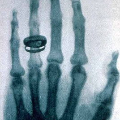In biomedical image analysis, the applicability of deep learning methods is directly impacted by the quantity of image data available. This is due to deep learning models requiring large image datasets to provide high-level performance. Generative Adversarial Networks (GANs) have been widely utilized to address data limitations through the generation of synthetic biomedical images. GANs consist of two models. The generator, a model that learns how to produce synthetic images based on the feedback it receives. The discriminator, a model that classifies an image as synthetic or real and provides feedback to the generator. Throughout the training process, a GAN can experience several technical challenges that impede the generation of suitable synthetic imagery. First, the mode collapse problem whereby the generator either produces an identical image or produces a uniform image from distinct input features. Second, the non-convergence problem whereby the gradient descent optimizer fails to reach a Nash equilibrium. Thirdly, the vanishing gradient problem whereby unstable training behavior occurs due to the discriminator achieving optimal classification performance resulting in no meaningful feedback being provided to the generator. These problems result in the production of synthetic imagery that is blurry, unrealistic, and less diverse. To date, there has been no survey article outlining the impact of these technical challenges in the context of the biomedical imagery domain. This work presents a review and taxonomy based on solutions to the training problems of GANs in the biomedical imaging domain. This survey highlights important challenges and outlines future research directions about the training of GANs in the domain of biomedical imagery.
翻译:在生物医学图像分析中,深度学习方法的适用性直接受到可用图像数据量的影响。这是因为深度学习模型需要大量的图像数据集才能提供高水平的性能。生成对抗网络(GANs)已经被广泛应用于通过生成合成生物医学图像来解决数据限制问题。GAN由两个模型组成,生成器和鉴别器。生成器学习如何根据所接收到的反馈产生合成图像。鉴别器是一个能够将图像分类为合成或真实的模型,并提供反馈给生成器的模型。在训练过程中,GAN可能会遇到几个技术挑战,这些挑战会妨碍实现合适的合成图像。首先是模式崩溃问题,即生成器要么产生相同的图像,要么从不同的输入特征产生统一的图像。其次是非收敛问题,即梯度下降优化器无法达到Nash均衡。第三是梯度消失问题,即由于鉴别器达到最佳分类性能,从而不向生成器提供有意义的反馈而导致不稳定的训练行为。这些问题导致合成图像模糊、不真实、缺乏多样性。迄今为止,在生物医学图像领域还没有一篇综述文章来概述这些技术挑战对GAN的影响。本文提出了一份综述和分类,以及GAN在生物医学图像领域的训练问题的解决方案。本文强调了重要的挑战,并概述了GAN在生物医学图像领域的未来研究方向。


